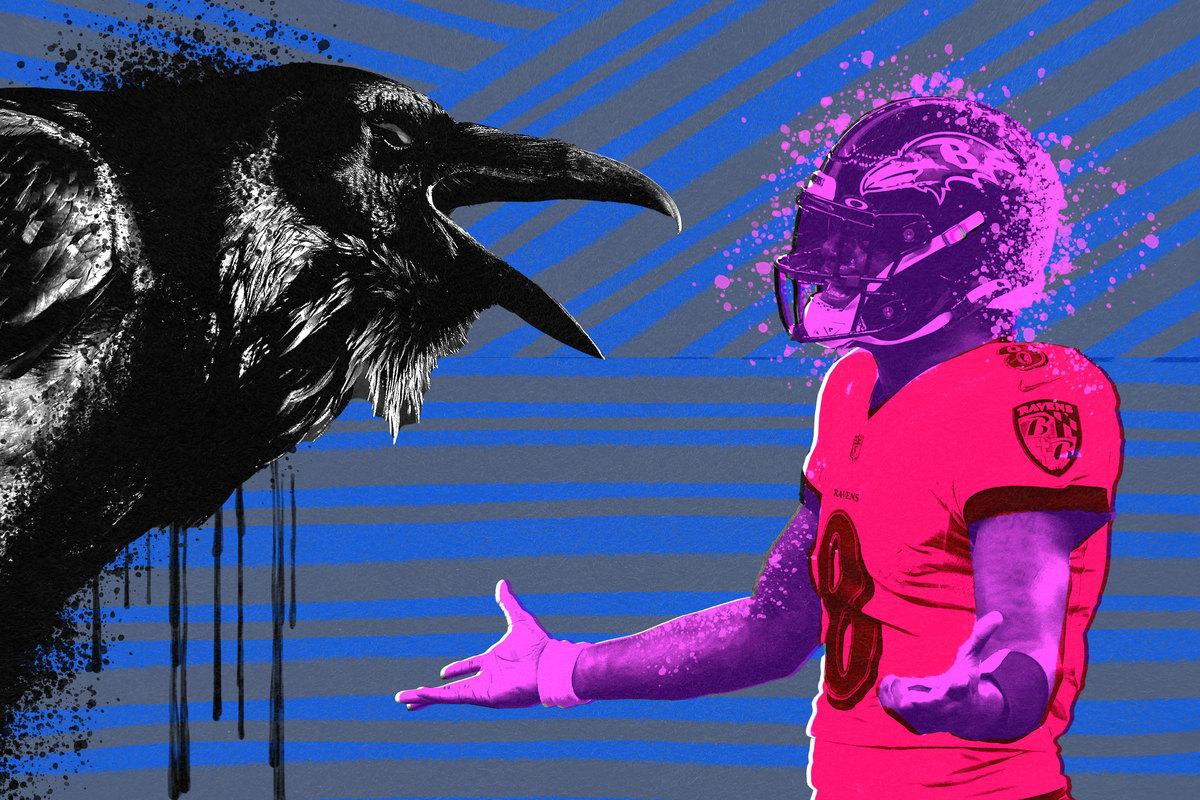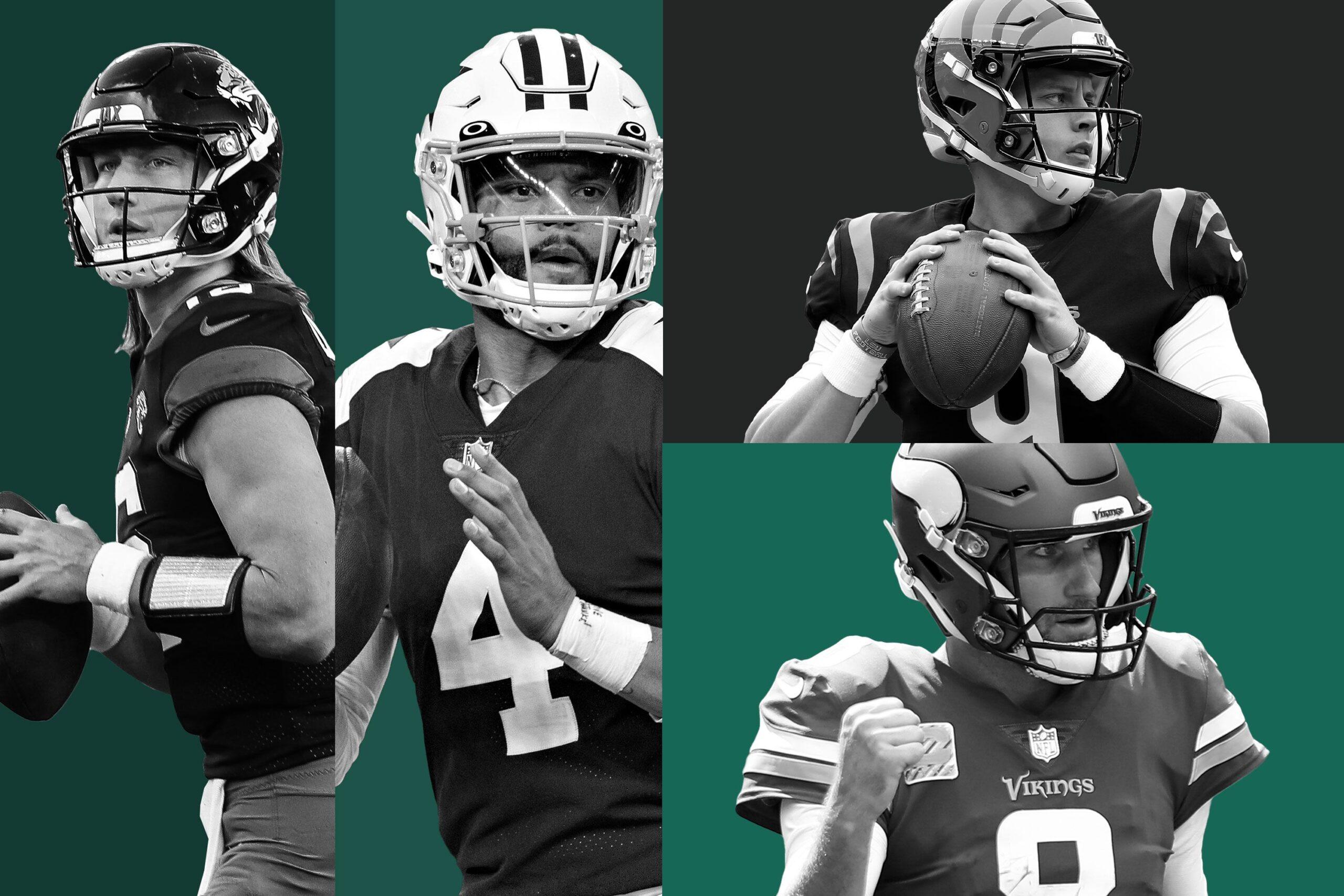
You can always tell how insecure a fan base is about a player’s future by how easily it can be rattled by a social media post. Lamar Jackson, who entered the offseason without a contract after the Ravens were eliminated from the playoffs over the weekend, has been putting that theory to the test. On Tuesday, fans in Baltimore assembled on various platforms to share their interpretations of this banal post, which Jackson put on his Instagram story:
What did it mean? Lamar’s back is turned to the camera, which makes it seem like he’s leaving, right? Or, maybe, his jersey number being cropped to look like a zero means the team is out of time. Wait, I got it: His back is to the camera to signify that he’s coming back. Yeah, that’s it—nothing to worry about.
It would be easier for Ravens fans to gaslight themselves into believing everything will be fine if Jackson hadn’t skipped the team’s road trip to Cincinnati over the weekend, an act that sparked rampant speculation. And then on Monday, Jackson posted this to his Instagram feed:
Uh-oh. That reads like an angsty teen who’s in the middle of a dramatic breakup. The 26-year-old clearly isn’t feeling appreciated, but by whom? Of course, many assume it’s the team, but it’s easy to forget that athletes are human beings with lives outside of the sports they play. Jackson’s post could have nothing to do with his contract negotiations, or it could have everything to do with them. Regardless, this much is clear: The Ravens will have a football game to play in nine months, and as of now, Jackson is not contractually obligated to play in it.
Typically when we see a team’s starting quarterback get to this point, it’s a midtier guy who’s straddling the line between “long-term starter” and “possible liability,” like Blake Bortles or Baker Mayfield. It’s not usually a former MVP who’s just entering the prime of his career. Those quarterbacks rarely even reach the final year of their four-year rookie contracts before getting an extension from their teams. But the Ravens not only let Jackson play out that final year, they also let him play on his fifth-year option. The only other former first-round passers who’ve done that were Jameis Winston and Marcus Mariota. Neither played another down for their respective teams.
We’re still a ways away from that becoming Jackson’s reality, but it’s shocking that it’s even gotten to this point. So how did the Ravens let it get this far? And is there really a chance they let a generational quarterback talent just leave?
Jackson and the Ravens were already in a bad spot when these drawn-out contract talks bled over into the regular season. It had been assumed that a deal would be wrapped up over the summer—deals of this magnitude don’t usually get done during the regular season—but there was a glaring lack of updates on that front. And when Lamar’s no. 1 receiver, and close friend, Marquise Brown was traded to Arizona during the draft, we got the first public display of discontent from Jackson. You throw a vague injury situation on top of it all, and the social media drama we’ve seen this week makes a little more sense.
Jackson suffered a PCL strain early in Baltimore’s Week 13 win over the Broncos. At the time, Ravens head coach John Harbaugh framed it as a knock that would keep him out for “days to weeks.” That was in early December. The knee injury turned out to be a season-ender that kept Jackson out of the AFC North title decider in Week 18 and Sunday’s playoff loss. As the weeks went on and Jackson remained sidelined, Harbaugh’s tone when discussing the recovery turned increasingly pessimistic:
Frustration was clearly mounting as this seemingly minor injury continued to keep Jackson on the sideline. That sparked speculation and debate over Jackson’s commitment to the team and his rehab process. His teammates were even being asked about it. Receiver Sammy Watkins, who joined Baltimore after Jackson went out, made headlines with comments that kind of, sort of suggested the quarterback should be out there playing: “In this league, everybody is pretty much banged up, hurt,” Watkins told The Washington Post ahead of the Bengals game. “I don’t want to speak for him and his situation and whatever he’s going through with the contracts. I don’t know what world he’s in. But for me, you got a chance to do something special. … He can will this team to a Super Bowl. I don’t think he’s thinking about it that way.”
Not long after that, Lamar came out with a statement explaining that he was still having issues with the knee despite the work he had put in to rehab it.
After the Bengals loss, some of Lamar’s teammates came out in full support of their quarterback. Team leaders like Marlon Humphrey and Calais Campbell have vouched for Lamar’s dedication to both the team and his rehab work. But Campbell did throw a little bait out there for the skeptics.
“I truly believe he worked as hard as he could to give him a chance to play,” Campbell said, via The Baltimore Banner. “As he gets older and more wise, he’ll learn how to take care of his body in different ways. He’ll have to learn that process of doing pre-hab so you doesn’t have to do rehab, but that’s something that comes from time. When I was 26, I didn’t know what I know now. There’s plenty of time for him to learn and grow.”
I highly doubt Campbell meant much by the comment, but there is a bit of a difference between a 26-year-old defensive end not doing the most to take care of his body, and a 26-year-old quarterback who’s seeking a nine-figure contract. And even the most ardent Lamar supporters—I consider myself one and believe he’s a top-five quarterback—can’t deny that his recent injury record is concerning. This was the second season in a row that Jackson was unable to finish. Last year it was an ankle injury that kept him out, but the result was the same: The Ravens were leading the AFC North when he went down. He was sidelined for longer than expected, missed the rest of the year, and Baltimore sank in the standings.
In that respect, I could see how committing to pay Jackson a quarter of a billion dollars, with a bunch of money guaranteed, would be difficult for Baltimore. But the thing is, we don’t really know what Jackson is looking for in his next deal. There have been reports that he wants a contract on par with the one Deshaun Watson got from the Browns this past offseason—with the sticking point being the guaranteed portion of the deal. Watson, despite being named in 26 civil lawsuits in which women said he turned professional massages into coercive, unwanted sexual encounters, got all $230 million of his five-year pact fully guaranteed. Reports have said Jackson is seeking a deal structured similarly to Watson’s, including full guarantees. The fact that Jackson doesn’t have an agent probably means we’re only getting the team’s side of the story in any of these media leaks, but he did tweet in August that he hadn’t received an offer like that.
The entire discussion surrounding Jackson is based on speculation. We don’t really know how his knee is feeling or how dedicated he’s been to his rehabilitation. We don’t really know what he’s asking for in contract negotiations, or where his head is at on returning to Baltimore at all. But we do know this: Jackson’s teammates love him and he’s the best player on the team. Before all of this other stuff started popping up, the debate on how much the Ravens would be willing to pay a quarterback like Jackson was based solely on outdated stereotypes of mobile, Black quarterbacks. There were concerns about the sustainability of his health … despite the fact the injuries he’s suffered have come on plays in which he was in the pocket. There were concerns about his passing ability … despite the fact he ranks eighth in passing EPA since 2019, according to TruMedia.
Jackson’s injury and the subsequent meltdown of Baltimore’s offense, which hadn’t scored more than a touchdown during his absence until Sunday when it scored a whopping two touchdowns, once again proved what we already know: The Ravens need Lamar more than Lamar needs them. He’s the best player on the team and almost certainly the best offensive player in team history.
For that reason alone, letting Jackson walk—or even tempting fate by playing the franchise tag game with him—shouldn’t be an option. The only real options are getting a long-term deal done as soon as possible, or, and this should be a last resort, trading him for an impossibly large haul of draft capital. If the trade compensation for an aging star like Russell Wilson was two first-round picks, two second-rounders, and three players, imagine what it would be for a 26-year-old former MVP. The NFL doesn’t allow teams to trade picks from drafts more than a few years into the future, so it might not even be possible for another front office to put together a package worthy of a player like Lamar. Baltimore would almost certainly be giving him away for pennies on the dollar.
For those reasons, I believe Ravens fans can relax and take a deep breath. NFL teams do some dumb shit, but they don’t just let superstar quarterbacks leave the building without a fight. We saw this last year when the Cardinals and Kyler Murray put their differences and very public squabbles aside to get a long-term deal done. Baltimore has its own experience with this, too. A decade ago, the organization was locked in complicated contract talks with Joe Flacco, who wasn’t nearly the player Jackson is but was seeking franchise-quarterback money. The Ravens were understandably reluctant to pay Flacco, who had led the team to some playoff success but was widely viewed as a middle-of-the-road starter at the time. A deal didn’t get done before the 2012 season, the final year of his contract, and the debates lasted until Flacco went on a historic postseason run and led Baltimore to its second Super Bowl title. Not long after that, the team made Flacco the highest-paid player in football, and while it was widely viewed as an overpay, it was seen as a price that had to be paid.
A decade later, the Ravens find themselves in a similar spot, only without a Lombardi Trophy to make negotiations more straightforward. The solution to the problem, however, remains just as obvious: Just pay the man whatever he wants.


